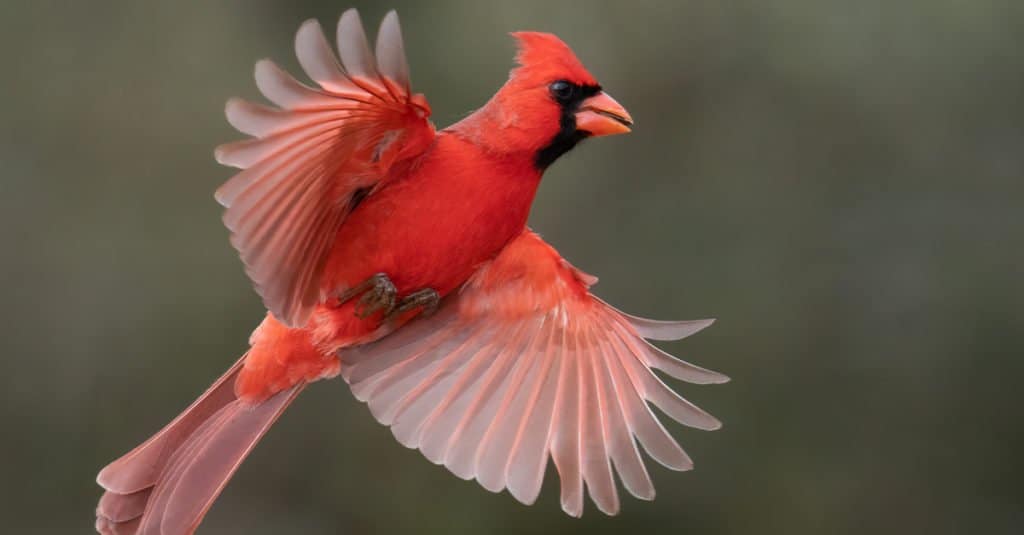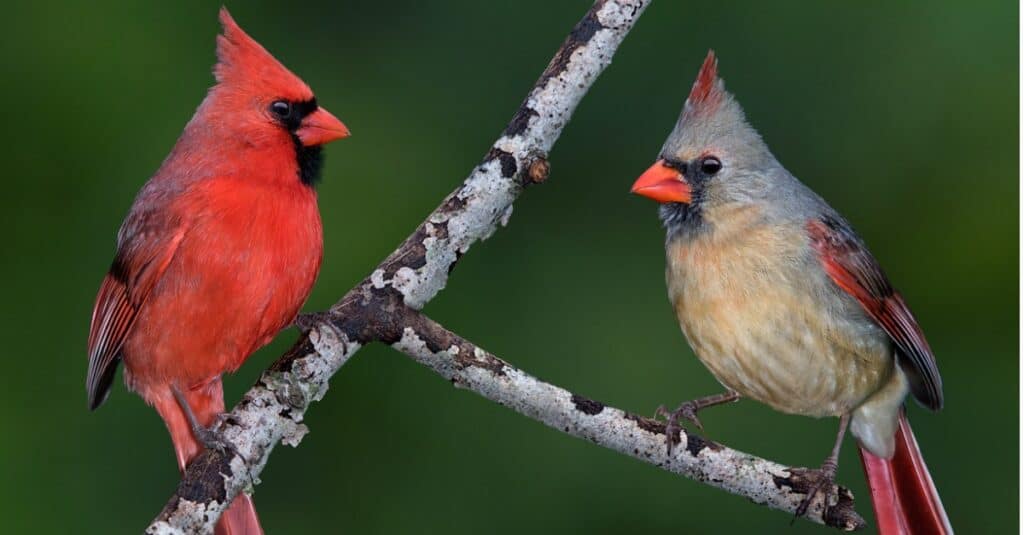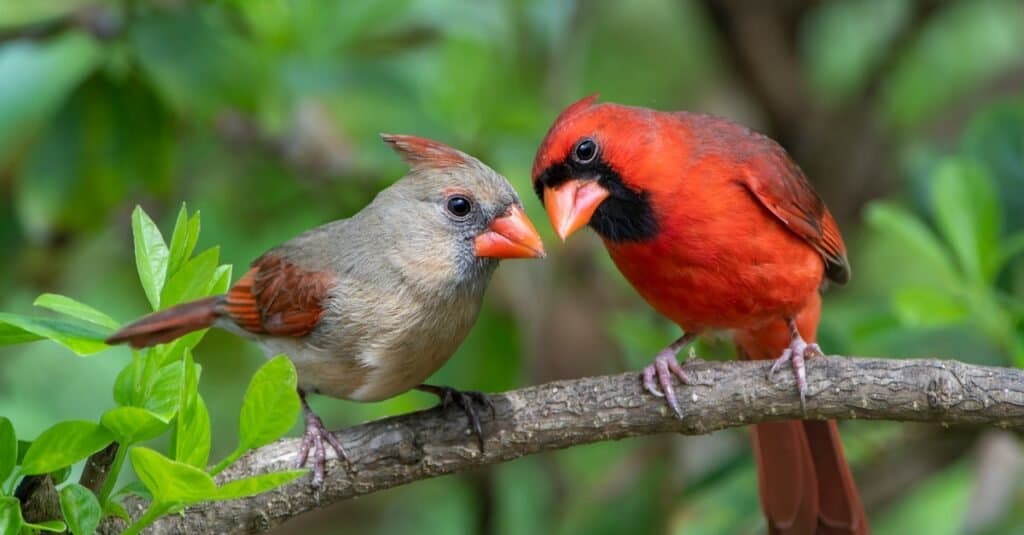Few backyard birds are as popular as the northern cardinal, a regular visitor to bird feeders here in the United States. Due to its bright red color and pointed crest on its head, this beautiful bird is instantly recognizable. Bird enthusiasts often place bird feeders outside their homes, hoping that one of these gorgeous red birds will land on them for a quick meal.
Cardinals are usually among the first birds to visit feeders in the morning and the last to do so at night. Interestingly enough, they are also quite romantic birds and great parents. So, have you ever wondered when the cardinal mating season begins? Find out when cardinals breed and other fun and interesting facts about this beautiful bird.
A Quick Rundown on Cardinals

Northern cardinals got their name because of the red biretta and robes worn by Catholic cardinals.
©Rob Palmer Photography/Shutterstock.com
Let’s begin by getting to know the northern cardinal. The northern cardinal’s name dates back to the time of the founding colonists of the United States. This is because of its vibrant red plumage and similarity to the red biretta and robes of distinguishable Catholic cardinals. As granivorous animals, northern cardinals consume mostly seeds as part of their diet. They have cone-shaped beaks that crack open seed hulls and nut shells. Cardinals love seeds, so if you use sunflower seeds, safflower seeds, cracked corn, or shelled peanuts in your feeders, you will be able to attract them.
Did you know, however, that not all northern cardinals are as bright red as we are used to seeing them? It is actually only the males that showcase such a bright red color. All males are bright red except for their faces which are black. A female has a light brown body and a reddish crest, wings, and tail. The faces and chests of females are very small and black. The Southwest, Midwest, and Eastern parts of the United States are all home to a large number of northern cardinals. Due to these birds’ non-migratory nature, residents of the country’s eastern half can see them throughout the year.
When Is Cardinal Mating Season?

Mating season for cardinals starts during the early spring.
©Cathy Keifer/Shutterstock.com
Early spring marks the start of the mating season for cardinals of all kinds. It is between March and September that northern cardinals breed. Each year, they raise two broods, with one starting around the middle of March, and the other, lasting from July to the end of August. During the breeding season, the female builds a cup-shaped nest in the dense foliage of shrubs and vines.
The nest is constructed from twigs, strips of bark, and grass, and the nest’s liner is lined with leaves, grass, or the bird’s own hair. In the next couple of days, the female will lay three to four white and greenish eggs and will incubate them until they hatch 11 to 13 days after they are laid. During the period when the female is busy incubating the eggs, the male brings food to her for consumption. The female will brood the chicks for the first two days of their life after they have hatched. The chicks are fed insects by both of their parents.
How Often Do Cardinals Mate?
The frequency of cardinal mating is often a mystery to people. A cardinal can lay eggs continuously over the course of a season, as sperm is always available to fertilize eggs in the female’s chambers between matings. Each pair of cardinals has between 2-4 broods per mating season, with each brood containing an average of one to five eggs.
Cardinals travel in pairs to find mates when the breeding season is in full swing. In addition, when they are traveling outside of that timeframe, they often travel in flocks with other cardinals that may or may not contain their mate.
What Do Cardinal Eggs Look Like?
Identifying whether or not a nest is a cardinal’s nest requires knowing what cardinal eggs look like.
Various color combinations are possible when it comes to their eggs. It is common for eggs from the same brood to be the same color, but they can vary from brood to brood. Color combinations for eggs are as follows:
- A light gray with brown or gray speckles
- Grey or brown speckles on a light green egg
- Specks of gray and brown on an ivory egg
Do Cardinals Mate for Life?

Cardinals are true romantics and will usually mate for life.
©Bonnie Taylor Barry/Shutterstock.com
There is a good chance that a cardinal will find a mate for the rest of their lives since they are monogamous birds. In most cases, the female constructs the nest with the assistance of the male, though both are involved in the process. This will usually take anywhere from 3 to 9 days, usually in the dense canopy of trees and shrubs. A northern cardinal primarily communicates with other members of the species by singing and using body signals.
It is interesting to note that both male and female cardinals can whistle loud, beautiful phrases. The birds use a large number of these songs to defend their territories, and they also use them to attract mates. The chip calls used by male and female cardinals serve to keep in touch with their mates. They can also be used for signaling danger to their partners. Furthermore, some birds may use body signals to signal alarm, for example, by flicking their tails or raising and lowering the crest of feathers on the top of their heads to show that they are in danger.
Cardinal Nesting Sites: Where Do They Nest?
There are many places where cardinals nest. It is more common for them to build their nest in dense shrubbery or among branches of small trees rather than in grass or open areas. The nests are usually built between one and fifteen feet above the ground. During incubation, only the female is responsible for keeping the eggs alive. Gestation is not a part of the bird’s life cycle. It can be said that incubation is the period between egg laying and hatching.
There will be two broods of cardinals raised by the male and female cardinals during every season. The female will construct a new nest for the second brood of eggs, and this old nest will not be reused for the second brood. For up to two weeks after the first set of young leave the nest, the male continues to help feed the young. The female will incubate her second clutch of eggs during this period.
When Do Baby Cardinals Leave the Nest?
Baby cardinals grow rapidly and are ready to leave the nest seven to thirteen days after hatching. Did you know that a baby cardinal leaves the nest more than once before returning to it again? When they leave their nests for the first time, they are described as fledglings. In the beginning, when the fledglings are just learning to fly and forage, they will return to the nest for several weeks. Juveniles are those who have just left their nest for the last time and are considered as having left for good.
When a baby cardinal leaves the nest for the first time, he or she stays with its parents for about 40 days. Young cardinals that hatched earlier in the season may even be forced to leave their parents sooner than usual. This is because their parents may kick them out of their territories earlier in the season. In addition to feeding the young, mom and dad cardinals will nest again, resulting in more mouths to feed. As a matter of survival, if the later brood needs to share its territory with the earlier brood to ensure survival, the parents have no choice but to send the earlier broods off to find new lands to call their own.
The photo featured at the top of this post is © Bonnie Taylor Barry/Shutterstock.com
Thank you for reading! Have some feedback for us? Contact the AZ Animals editorial team.






